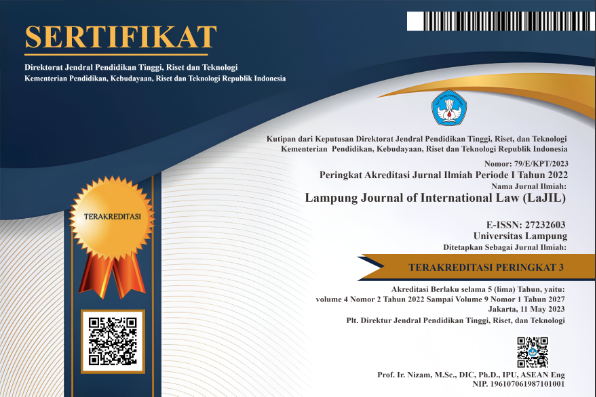PROTECTION OF CHILDREN’S PERSONAL DATA IN THE DIGITAL WORLD BASED ON NATIONAL AND INTERNATIONAL LEGAL FRAMEWORK
DOI:
https://doi.org/10.25041/lajil.v1i1.2020Abstract
The crime of children’s data in the digital world is one of the causes of the rampant crime of bullying, fraud, theft, sexual harassment, exploitation and abduction which leads to the trafficking of people who make children victims. The method used in this paper is a juridical-normative comparative legal research method. The result shows that the Convention on the Rights of Child Convention 1989 (CORC) does not regulate the personal data in the digital world comprehensively. So far, countries in the world, including Indonesia, have only relied on the international legal framework. It is recommended, including international guidelines issued by several international organizations such as the Organization for Economic Co-operation and Development (OECD), Asia Pacific Economic Cooperation (APEC), and the International Telecommunication Union regarding the guidelines for parents and children in 2016. Indonesia already has a set of legal rules that are used as a basis for protecting children’s rights in the digital world. Based on these rules, the protection of children’s data in the digital world is included in the private and criminal domain. These Legal Frameworks show that the government is passive in protecting children’s data in the digital world because the responsibility of child safety and security when online is still focused on the parents or guardians of the child.Keywords:
Protection, Personal Data, Term, International, National,References
Mulyadi, Fitriani Mahmud., Ekaputra, M., Bariah, Chairul. “TINDAK PIDANA PENELANTARAN RUMAH TANGGA MENURUT UNDANG-UNDANG NOMOR 23 TAHUN 2004 TENTANG PENGHAPUSAN KEKERASAN DALAM RUMAH TANGGA (STUDI PUTUSAN MAHKAMAH AGUNG NOMOR 467K/PID.SUS/2013),” USU Law Journal 3, no. 28, 2015: 28-39.
Hutabarat, Marojahan “ANALISIS PERBANDINGAN PUTUSAN HAKIM ATAS TINDAK PIDANA PERSETUBUHAN DAN TINDAK PIDANA PERCABULAN TERHADAP ANAK,” Cepalo 2, no. 2, 2019: 93–102, DOI: 10.25041/cepalo.v2no2.1766.
Prints, Darwan. Hukum Anak Indonesia. Bandung: Citra Aditya Bakti, 2003.
Sofyan, Andi et.al. Hukum Pidana. Makassar: Pustaka Pena Press, 2016.
Sujadmiko, Bayu. Pengantar Hukum Teknologi Informasi Internasional. Bandar Lampung: Zam-zam Tower, 2017.
United Nation Children’s Fund. Child Protection Information Sheet. New York: The Child Protection Section Programme Division UNICEF, 2006.
APEC Privacy Framework 2015.
Government Regulation Number 43 Year 2017 concerning Implementation of Restitution for Children Who Become Victims of Criminal Acts.
Law Number 11 Year 2008 concerning Updated Information and Electronic Transactions Law Number 19 Year 2016 concerning Amendments to the Law
Law Number 23 Year 2002 concerning Child Protection which has been updated with Law Number 35 Year 2014 concerning Amendments to Law Number 23 Year 2002 concerning Child Protection
OECD The Protection of Children Online 2012. Convention on Rights of the Child 1989.
Regulation of the Minister of Communication and Information Number 20 Year 2016 concerning Protection of Personal Data in Electronic Systems.
International Telecommunication Union Guidelines for Children on Child Online Protection 2016.
International Telecommunication Union Guidelines for Parents, Guardians and Educators on Child Online Protection 2016.
http://fortune.com/2015/11/30/vtech-hacking-children-data/, accessed on June 26, 2018.
http://fortune.com/2018/04/24/stolen-identity-theft-children-kids/, accessed on June 26, 2018.
https://www.itgovernance.eu/blog/en/more-data-lost-or-stolen-in-2017-than-all-of-2016-but-europe-bucks-the-trend, accessed on June 26, 2018.
Downloads
Downloads
Published
How to Cite
Issue
Section
Copyright
Copyright (c) 2020 Lampung Journal of International Law
License

This work is licensed under a Creative Commons Attribution-ShareAlike 4.0 International License.






